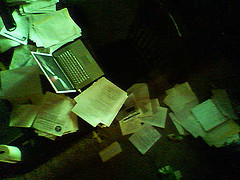 Matt Kirschenbaum entame un projet à l’image de ce que l’on souhaitait tous secrètement qu’il advienne : comment gérer, colliger et archiver des documents numériques dans la sphère littéraire… C’est toute la question du brouillon numérique qui est ici envisagée : à la conjonction, donc, de la technologie, de la génétique littéraire et de la médiologie. Il s’attaquera ni plus ni moins aux vieux laptops de Salman Rushdie, à titre de matériau expérimental…
Matt Kirschenbaum entame un projet à l’image de ce que l’on souhaitait tous secrètement qu’il advienne : comment gérer, colliger et archiver des documents numériques dans la sphère littéraire… C’est toute la question du brouillon numérique qui est ici envisagée : à la conjonction, donc, de la technologie, de la génétique littéraire et de la médiologie. Il s’attaquera ni plus ni moins aux vieux laptops de Salman Rushdie, à titre de matériau expérimental…
Today nearly all literature is « born digital » in the sense that at some point in its composition, probably very early, the text is entered with a word processor, saved on a hard drive, and takes its place as part of a computer operating system. Often the text is also sent by e-mail to an editor, along with ancillary correspondence. Editors edit electronically, inserting suggestions and revisions and e-mailing the file back to the author to approve. Publishers use electronic typesetting and layout tools, and only at the very end of this process almost arbitrarily and incidentally, one might say is the electronic text of the manuscript (by now the object of countless transmissions and transformations) made into the static material artifact that is a printed book. (Hamlet.doc ?)
Travaux à suivre de près, considérant les énormes besoins auxquels feront face les archivistes et généticiens littéraires dans les prochaines années…
(photo: « did i mention… », gish700, licence CC)